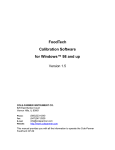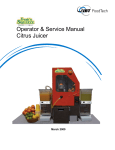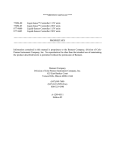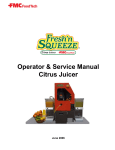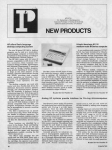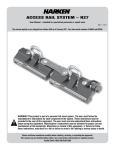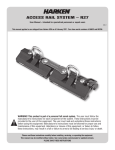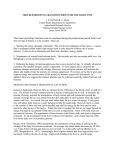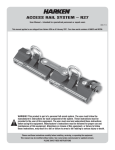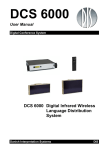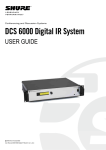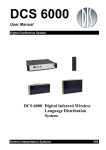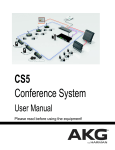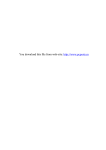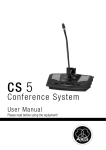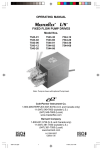Download ZX-50 PORTABLE GRAIN ANALYZER - Cole
Transcript
FoodTech Source™ PORTABLE FOOD ANALYZER with AutoBIAS™ USER'S MANUAL Version 2.1 COLE PARMER INSTRUMENT CO. 625 East Bunker Court Vernon Hills, IL USA 60061 Phone: Fax: E-mail: Website: 847-549-7600 847-247-2983 [email protected] http:/www.coleparmer.com © Zeltex, Inc. 2001 This manual provides you with all the information needed to operate the Cole-Parmer FOODTECH™ TABLE OF CONTENTS WARNING: 4 ABOUT THE FOODTECH™ 5 FEATURES OF THE FOODTECH™ UNPACKING THE FOODTECH™ PREPARATION ELECTRICAL REQUIREMENTS OPTIONAL PRINTER PRINTER PAPER INSTALLATION FOR OPTIONAL PRINTER SAMPLE CUP CLAM-SHELL CUP VARIABLE PATHLENGTH SAMPLE CUP KEYPAD DESCRIPTION TURNING THE FOODTECH™ ON FOR THE FIRST TIME AUTOMATIC BIAS INITIALIZATION AND STANDARDIZATION ANALYZED SAMPLE FORM SELECT PRODUCT MENU SELECTIONS MEASURING A SAMPLE ADJUSTING THE CALIBRATION ADJUSTING THE BIAS AUTOBIAS ADJUSTING THE TIME ADJUSTING THE DATE ADJUSTING THE NUMBER OF READ CYCLES STORE SAMPLES DATA LINK PRINTING PAPER FEED RESET ID # WARNINGS AND ERROR CODES 5 5 7 7 7 7 8 9 12 13 14 15 17 18 18 19 21 22 22 23 23 23 24 24 25 25 26 27 2 GENERAL SPECIFICATIONS 31 GLOSSARY 32 APPENDIX I 34 COMBINATION LOCK 34 INDEX 35 A NOTE ON THE TEXT Throughout this manual, keystrokes are represented in bold type; references to messages on the computer screen or the FOODTECH™ display screen are in “quotations.” 3 WARNING: THE FOODTECH™ PORTABLE NEAR-IR ANALYZERS ARE NOT EXPLOSION PROOF: REASONABLE CARE MUST BE USED IN HANDLING THESE INSTRUMENTS. THE FOODTECH™ IS SUPPLIED WITH A SPECIAL STATIC-FREE CLEANING BRUSH. FAILURE TO USE THIS BRUSH BETWEEN SAMPLES MAY CAUSE BAD READINGS. 4 ABOUT THE FOODTECH™ FEATURES OF THE FOODTECH™ Easy sampling: no grinding, no preparation Analyzes whole grain products such as wheat (spring and winter), barley, soybean and corn Analysis in 60 seconds or less Stores calibrations for 3 constituents each of up to 10 products Accurate up to 95% of moisture, protein, oil, etc. Able to analyze samples at temperatures from -20ºC to +50ºC. Direct readout in percentage form for both AS-IS and CM Totally solid state optics (no moving parts) Automatic Bias Initialization and Standardization UNPACKING THE FOODTECH™ Check that all items 1 through 6 are in the box. If any items are missing, please contact Cole-Parmer immediately. 1. 2. 3. 4. 5. 6. FOODTECH™ Portable Food Analyzer (PFA) User's Manual Quick Start Manual AA Batteries 16 mm Sample Cups Static Brush Optional: 1. Carrying Case 2. Software Disk and Calibration Manual 3. A/C Adapter 4. RS232 Cable 5. Printer 6. Printer Paper 7. 25 mm Sample Cup (corn, soybean) 8. Variable Pathlength Sample Cup 5 mm-16 mm (small grains) 9. AutoBIAS perma-sample The optional carrying case has the combination set at the factory to open at 000. You may leave it at this setting or you can set your own combination. (See Appendix 1 in this manual for instructions on how to set your own combination.) 5 APPEARANCE AND PART NAMES 6 PREPARATION ELECTRICAL REQUIREMENTS After you have opened the carton, take a moment to consider where to place the FOODTECH™ The instrument has been designed to work flawlessly in the manufacturing environment, but please take into account the following requirements before setting up the instrument. The FOODTECH™ operates from six AA cells or 9v DC from an A/C adapter. For the best operation and the most reliable analysis, the FOODTECH™ should have a clean, independent electrical line with the A/C adapter. Depending on the A/C voltage at the customer’s site, the appropriate adapter (nominal 115 or 230 VAC) is shipped with the instrument. Connect the A/C adapter cable to the jack closest to the top on the right-hand side of the instrument. Also, insert six 1.5v AA size alkaline batteries into the battery compartment located on the rear of the main body. Be sure the batteries are oriented as indicated in the compartment. OPTIONAL PRINTER The optional printer can be attached directly to the FOODTECH™ PRINTER PAPER INSTALLATION FOR OPTIONAL PRINTER 1. Remove the clear plastic cover from the printer. 2. Cut the end of the roll at an angle to form a point in the center. 3. Feed the paper into the slit inside the Paper Roll Compartment and press the PAPER FEED key. 7 SAMPLE CUP The FOODTECH™ is shipped with 2 standard 16mm (approx. 3/4”) sample cups to be used with wheat and barley. A 24mm (approx. 1”) cup and a variable pathlength cup are also available. Do not place objects on the sample cup. It should not be placed in direct heat or cleaned with harsh chemicals such as scouring powder. Molded 16mm Cup Stock #2670 Variable Path-Length Cup Stock #2672 24mm Cup Stock #A-572 Clam-Shell Cup Stock #A0636 8 CLAM-SHELL CUP The A0636 Clam-shell Cup allows the analysis of pastes and slurries in clear “whirl-pak”–type bags. The Clam-shell Cup includes an internal A0633 Thermistor Module (a), contact strips (b), windows in the body and door (c), and an assortment of different thickness windows (d). Because the Clam-shell cup has its own thermistor, the thermistor probe in the instrument must be removed. First, locate the thermistor cover (e). It is the smaller of the two covers on the bottom of the instrument. Remove the thermistor cover by pressing down with the thumbs, and sliding the cover upward. 9 Inside the thermistor recess, you’ll note the Thermistor Probe assembly (f) (held in with two 6-32 screws), and the Black Spacer (g). Remove the Black Spacer (held in with tape), and the Thermistor Probe, exposing the Contact Board (h). Note the red and green wires which are connected to the Contact board. This is a close-up of the A0516 Thermistor Probe. Note that one end of the probe is painted green. If the Thermistor Probe is re-installed later, the green end should be closest to the green wire on the contact board. 10 To plug the holes in the sample chamber, make a Spacer Assembly from the Gray Stop Plate, the Black Spacer, and two 6-32 screws. Install the Spacer Assembly as shown. Storing the Thermistor Probe as shown will keep it from getting lost. Re-install the Thermistor Cover, and you’re done. To convert back, reverse the procedure. 11 VARIABLE PATHLENGTH SAMPLE CUP The Variable Pathlength Sample Cups uses windows of different thicknesses slide in and out of slots 12 KEYPAD DESCRIPTION The Cole-Parmer keypad is designed to be easy to use. ENTER This key is used after a selection has been made on the menu. PRODUCT This key is used to make a product selection. SELECT ESC This key is used before entering any adjustable programming within the instrument. It can also be used to cancel a current entry in the instrument. MEASURE This key is used to make measurements. CM * AS-IS This key toggles the displayed result between Protein on a Constant Moisture basis or on an AS-IS basis. ▲▼ These arrow keys cycle through menu selections. 13 TURNING THE FOODTECH™ ON FOR THE FIRST TIME 1) If you are using batteries, simply turn on the FOODTECH™ by the switch on the right side and go to step 3). If you are running the FOODTECH™ on batteries, please make sure the instrument is shut off when not in use. The batteries will last much longer if the instrument is off when sitting idle. 2) Plug the adapter into the right side of the FOODTECH™ Turn on the power switch. The FOODTECH™ begins a test sequence: “TEST EPROM, TEST RAM, TEST IREDS, TEST ADC, TEST THERM.” When “Measure Standard” is displayed, the test sequence has been completed. 3) Run the AutoBIAS sample (if option is installed), following the directions on page 15. 4) Measure ten samples of the product that the instrument has been calibrated for. (These samples must have already been analyzed by your lab.) Write the analysis in the chart provided on page 17 and fax the form or call Cole-Parmer at: FAX: 1-847-247-2983 PHONE in the USA: 1-888-409-3663 outside the USA: 1- 847-549-7600 Cole-Parmer will give you any necessary adjustments. 14 AUTOMATIC BIAS INITIALIZATION AND STANDARDIZATION (Optional) When you turn the instrument on each day, it will require you to run an AutoBIAS sample in each product you use.* The AutoBIAS feature uses the latest NIR technology to prevent the FOODTECH™ from drifting out of calibration. The instrument will prompt, “BIAS ADJUST [product].” Press ENTER. The instrument will read the empty chamber, then prompt, “Insert Sample.” Do so; then press MEASURE. The screen will prompt, “Remove & Turn.” DO NOT TURN THE CUP: the perma-sample can only be inserted one way. Just press MEASURE. Remove and replace the sample when prompted; press MEASURE. Remove the sample when prompted and press MEASURE. The instrument will read the empty chamber again. The instrument will decide how many times it needs to read the sample. At this point, it may prompt, “READ AGAIN.” If it does so, DO NOT INSERT THE SAMPLE. Press MEASURE. After it reads the empty chamber again, it will tell you to “Insert Sample.” Repeat the process. It may ask you to read the sample several times. Do not be alarmed. Simply follow the directions until the screen gives the constituent name and a value. This value is the amount of the bias adjustment for that constituent: Write it on the attached Daily AutoBIAS Adjustment Record. Press ENTER. The instrument will automatically adjust the bias by the amount shown. The second constituent bias amount will appear. Record it and press ENTER again. Continue until all the constituents have been adjusted. You are now ready to begin reading samples in the adjusted product! You can elect to run an AutoBIAS at any time, in addition to the daily AutoBIAS prompt. Make sure you are in the product whose bias you want to adjust. Press SELECT ESC. Use the arrow keys (▲▼) to scroll through the menu until “Auto Bias” appears on the screen. Press ENTER. * If you are unable to run the AutoBIAS sample for some reason, you can escape the daily AutoBIAS prompt by pressing the arrow keys in the following order: up, down, up (▲▼▲). Do not make a habit of ignoring the AutoBIAS prompt. If you have lost the AutoBIAS sample, contact Cole-Parmer for a replacement. 15 DAILY AutoBIAS™ ADJUSTMENT RECORD Keep a blank copy of this sheet. PRODUCT # and NAME DATE CON 1 AutoBIAS AMOUNT FOR CON 2 CON 3 CON 4 ___/___/___ ___/___/___ ___/___/___ ___/___/___ ___/___/___ ___/___/___ ___/___/___ ___/___/___ ___/___/___ ___/___/___ ___/___/___ ___/___/___ ___/___/___ ___/___/___ ___/___/___ ___/___/___ ___/___/___ ___/___/___ 16 ANALYZED SAMPLE FORM SEND TO: Cole-Parmer Instrument Co., USA, FAX NO.: 1-847-247-2983 FROM: Company name, Country ___________________________________________ CONTACT PERSON: (please print) _________________________________________ PHONE: Country code ________ Number __________________________________ FAX: _____________________________________________________________________ Enter in the Analyzed Sample columns ten (10) samples that have been analyzed by your lab. In the corresponding columns, enter the FOODTECH™ readings for the same samples. Fax to Cole-Parmer for advice concerning any needed adjustments. Sample Number Analyzed Sample Lab Protein AS-IS FOODTECH Protein AS-IS ™ Analyzed Sample Lab Moisture FOODTECH ™ Moisture Analyzed Sample FOODTECH Lab ™ _________ _________ 1 2 3 4 5 6 7 8 9 10 17 SELECT PRODUCT 1. Press Product. Press the arrow keys (▲ ▼) to cycle through the products. The different products will be listed. (The Portable Food Analyzer is able to store ten products, numbered as 0-9.) 2. Press ENTER when the product to be tested is on the display. Only one product can be selected at a time. MENU SELECTIONS 1. Turn on analyzer. 2. After test sequence is complete, press Select Esc. “Enter Bias” will appear on the FOODTECH™ screen. 3. Press the arrow keys to cycle through the selections: Enter Bias - adjust the calibration Data Link - to communicate with the computer Store Sample - saves samples in internal memory to be downloaded to the computer Paper Feed - for the optional printer Reset ID # - resets the sample ID number to 1 Auto Bias - maintains calibration accuracy Set Date Set Time Printing - for the optional printer Set Readings - number of times that each sample is read—ColeParmer recommends 4 4. Press ENTER to select the option on the screen. 18 MEASURING A SAMPLE 1. Turn power switch ON. “FOODTECH™ PFA” will be displayed. The display will show a version number and then will begin a test sequence. “Measure Standard” will be displayed when the test sequence has been completed. 2. Select the product according to the sample type to be measured. (See “Select A Product”) 3. Fill the sample cup with sample and tap the cup twice on a hard surface. 4. Make sure there is nothing in the sample chamber and close the lid over the sample chamber. 5. Press MEASURE. The display will show “Reading . . .,” then “Insert Sample.” This indicates that the instrument has been standardized. The PFA must be standardized prior to making any measurement. 6. Lift the lid from the sample chamber and place the cup containing the sample in the chamber. 7. Replace the lid over the sample in the chamber. This shield must always be used when measuring a sample or a standard; otherwise, the results will be incorrect. 8. Press MEASURE. The display will show “Reading . . .,” then “Remove & Turn.” Remove the sample, rotate the sample cup 180 degrees and replace it in the FOODTECH™ PFA. Close the lid. 9. Press MEASURE. The display will show “Reading . . .,” then “Remove & Reload.” Remove the sample cup, pour out the sample, and refill the cup with the same sample. 10. Tap the sample cup twice on a hard surface, replace it in the sample chamber, and close the lid. 11. Press MEASURE. The display will show “Reading . . .,” then “Remove & Turn.” Remove the sample cup, rotate the cup 180 degrees, and replace it in the FOODTECH™ PFA. Close the lid. 12. Press MEASURE. The display will show “Reading . . .,” then “Remove & Press M.” Remove the sample. 19 13. Close the lid over the empty chamber and press MEASURE. 14. The results will be displayed. Use the down arrow key to list the results of each constituent. 15. To measure another sample of the same product, press SELECT ESC to clear the results. The instrument will return to “Measure Standard.” Repeat steps 3-14. Remember: At any prompt where you have to either enter a sample or remove a sample and press MEASURE, the instrument will allow you only 50 seconds to do so. If after the elapse of 50 seconds you have not completed the task required, the FOODTECH™ will flash “Time Out!” and automatically return to “Measure Standard.” This feature is designed to prevent readings from becoming “stale.” 20 ADJUSTING THE CALIBRATION The FOODTECH™ has been carefully calibrated at the factory or at your location; however, sometimes it is necessary to adjust the calibration for a bias. A bias adjustment fine tunes the FOODTECH™ by shifting all readings up or down by the same amount. A. Obtain ten laboratory-analyzed samples. B. Measure the samples in the FOODTECH™ C. Compare the instrument readings with the laboratory analysis or fax the data to Cole-Parmer at 847-247-2983 and Cole-Parmer will provide any necessary adjustments. See the following example of data requiring a bias adjustment. Example: Determine the average FOODTECH™ value and the average laboratory value. The difference between the two will be the bias adjustment. Sample Number 1 2 3 4 5 6 7 8 9 10 Column Average = FOODTECH™ Protein As-Is 10.0 11.1 12.3 10.4 9.1 10.8 12.0 11.2 8.8 9.6 10.5 Lab Protein As-Is 10.2 11.3 12.6 10.5 9.3 11.0 12.1 11.4 9.0 9.8 10.7 In the above example, the FOODTECH™ is reading Protein As-Is 0.2% too low (determined by the difference between the averages of the two columns). The bias adjustment will be +0.2 for Protein As-Is. 21 ADJUSTING THE BIAS 1. Turn on the instrument. 2. Make sure you are in the product that requires the bias adjustment. (See “Select a Product”) 3. When “Measure Standard” is displayed, press SELECT ESC. 4. “Enter Bias” will appear on the display. Press ENTER. 5. The product and constituent appear: Example: PØ WHT C1 PRO 6. Use the arrow keys to cycle through the constituents. Press ENTER after the constituent for which you are adjusting the bias appears. 7. “Bias: Ø.Ø” will appear. Use the arrow keys to cycle through the numbers. Press ENTER when the correct bias is displayed. Make sure the decimal point is in the right place. “Complete” will appear. 8. If for any reason you must abort, press SELECT ESC to abort the bias adjustment. AUTOBIAS 1. To run the optional AutoBIAS, select “Auto Bias” on the FOODTECH™ menu and press ENTER. (See also the AutoBIAS instructions on page 15.) 2. Follow the instructions on the screen, using the AutoBIAS perma-sample provided by Cole-Parmer or your own sealed AutoBIAS sample. (See the FOODTECH™ Calibration Manual for instructions on creating an AutoBIAS sample and setting the instrument to read a different AutoBIAS sample.) 3. Run the sample as many times as the instrument requests. 4. Record the date and the amount of the bias adjustment on a copy of the AutoBIAS Adjustment Record on page 16. 22 ADJUSTING THE TIME 1. Turn PFA on. 2. At the “Measure Standard” prompt, press SELECT ESC. 3. When “Enter Bias” is displayed, use the arrow keys ((▲ ▼) to cycle through the menu until “Set Time” appears. 4. Press ENTER. The up arrow key (▲) cycles through the hours. The down arrow key (▼) cycles through the minutes. The CM* AS-IS key zeroes the seconds. 5. Press ENTER after the time has been adjusted. ADJUSTING THE DATE 1. Turn on the PFA. 2. After the test sequence is completed, “Measure Standard” is displayed. 3. Press SELECT ESC. “Enter Bias” will appear. 4. Use the arrow keys to cycle through the menu to find “Set Date.” Press ENTER. The up arrow key (▲) cycles through the months. The down arrow key (▼) cycles through the days. The CM*/AS-IS key cycles through the years. 5. Press ENTER after the date has been adjusted. ADJUSTING THE NUMBER OF READ CYCLES The FOODTECH™ is designed to allow you to use between 1 and 9 repetitions to get the maximum accuracy needed for your samples in a minimum of time. Cole-Parmer recommends using four (4) repetitions. 1. Turn on PFA. 23 2. At the “Measure Standard” prompt, press SELECT ESC. 3. When “Enter Bias” is displayed, use the arrow keys (▲ ▼) to cycle through the menu to find “Set Readings.” Press ENTER. 4. “# Reads: 4” is displayed. Use the arrow keys to cycle through the numbers. Press ENTER at the number of your choice. STORE SAMPLES (Optional) The PFA is able to store the OD’s and sample ID’s for up to 25 samples in battery-backed RAM. The samples are stored in the same memory as the K values. This means that the sample readings are preserved even when the FOODTECH™ is turned off. The samples that are saved in the FOODTECH™'s memory can be downloaded to a PC. To save the last sample that was read: 1. Press SELECT ESC. “Enter Bias” will be displayed. 2. Use the arrow keys ((▲ ▼) to cycle through the menu until “Store Samples” appears. Press ENTER. 3. “Saved #______“ indicates the number (1-25) of the saved sample in the FOODTECH™’s memory. After saving 25 samples, the instrument will wrap around and begin to save again in position 1. This will overwrite the previous sample(s). The samples can be downloaded to the PC using the optional software by connecting the FOODTECH™ to the computer with an RS232 cable and selecting “Download Saved Samples” from the Utility Menu of the calibration program. See “Download Saved Samples” in the Calibration Manual. DATA LINK The FOODTECH™ must be in Data Link mode for it to communicate with the PC. The FOODTECH™ is connected to the PC with an RS232 cable. 1. Turn on PFA. 24 2. At the “Measure Standard” prompt, press SELECT ESC. 3. When “Enter Bias” is displayed, use the arrow keys ((▲ ▼) to cycle through the selections to find “Data Link.” 4. Press ENTER. “DATA LINK” will be displayed in capital letters. PRINTING This selection is used with the optional printer. To enable the printer: 1. Turn on the PFA. 2. At the “Measure Standard” prompt, press SELECT ESC. 3. “Enter Bias” will appear. Use the arrow keys (▲ ▼) to cycle through the menu to find “Printing.” Press ENTER. 4. “PRN ENABLED” will be displayed. Press ENTER. NOTE: Each time the FOODTECH™ is turned on, the printer must be enabled. To disable the printer: 1. Turn on the PFA. 2. At the “Measure Standard” prompt, press SELECT ESC. 3. “Enter Bias” will appear. Use the arrow keys (▲ ▼) to cycle through the menu to find “Printing.” Press ENTER. 4. “PRN DISABLED” will be displayed. Press ENTER. PAPER FEED This selection is used with the optional printer. The printer must be enabled (See above). To advance the paper on the optional printer: 25 1. Press SELECT ESC. “Enter Bias” will appear. 2. Use the arrow keys to cycle through the menu until “Paper Feed” is displayed. 3. Press ENTER. The paper will advance one line each time ENTER is pressed. 4. Press SELECT ESC to return to “Measure Standard.” RESET ID # This selection is used to reset the automatic sampling number to #1. 1. Turn on the PFA. Wait for “Measure Standard” to be displayed. 2. Press SELECT ESC. “Enter Bias” will appear on the display. 3. Use the arrow keys to cycle through the menu until “Reset ID #” appears. Press ENTER. 4. “ID # Reset” will be displayed. The next sample run will be labeled sample #1. 26 WARNINGS AND ERROR CODES The FOODTECH™ has a number of warnings and error codes built into it. Some are overridden automatically on the analyzer; others require you to start the reading again. The range for the warnings can be set by using the Instrument Edit Utility program on the Calibration Software. Error: TOO DARK 1) This error occurs if the energy reaching the detector is less than the acceptable level. Error: TOO LITE 2) This will be displayed if the detector is in saturation. This normally is caused by not placing the light shield on correctly while the instrument is reading a sample or measuring the standard. ****** WARNING ****** Error AMB. TEMP TOO LOW ******************** 3) The FOODTECH™ was set up with a temperature check for itself. If the instrument temperature is too cold, a warning, “AMB. TEMP TOO LOW” will appear on the display. This can be overridden by pressing ENTER. 27 ****** WARNING ****** Error AMB. TEMP TOO HIGH ********************* 4) This indicates that the instrument is above the recommended temperature range. ****** WARNING ****** Error SMP. TEMP TOO LOW ********************* 5) The FOODTECH™ was also set up with a temperature check for the sample. If the sample temperature is too cold, a warning, “SMP. TEMP LOW,” will appear on the screen. This can be overridden by pressing ENTER. ****** WARNING ****** Error SMP. TEMP TOO HIGH ********************* 6) This indicates that the sample temperature is above the recommended temperature range. ****** WARNING ****** * BAD CURVE * ******************** 7) This will be displayed only if A, B, and C have been activated using the Instrument Edit Utility program in the Calibration Software. 28 Note: When entering Curve Checking on the Constituent Menu you should always look at the curve on a typical sample on the computer. On the bottom of the computer screen the filter numbers are displayed. You should choose A as the highest peak of the sample, B as the second highest peak on the sample, and C as the low point of the sample. This allows you to verify that the curve is a reasonable shape for the curve you calibrated for. ****** WARNING ****** Error HIGH VAR *********************** 8) This is displayed if the variance among the four readings is more than normal variance in the sample. This tells you that the repeatability within the sample is not as reasonable as we would expect. This could be caused by light leaks, an improperly aligned sample, or just variations in the samples. ****** ERROR ****** VALUE TOO LOW ********************** 9) This occurs when the reading for a particular constituent is outside the range that was set up on the range of data on the Instrument Edit Utility program. 10) At any prompt where you have to either enter a sample or remove a sample and press MEASURE, the instrument will allow you only 50 seconds to do so. If after the elapse of 50 seconds you have not completed the task required, the FOODTECH™ will flash “Time Out!” and return to “Measure Standard.” This feature is designed to not allow readings to become “stale.” 29 ****** ****** NO CONS NAME ********************** 11) This is displayed after a sample reading to warn the user that the product selected to run the sample does not have constituents named for that product. ****** ****** LOW BATTERIES ********************** 12) This is displayed when the batteries need to be replaced. 30 GENERAL SPECIFICATIONS 1. MEASUREMENT Measuring Principle: Near-Infrared Transmittance based on technology from the United States Department of Agriculture 2. PRINTER OUTPUT (optional) Product and Constituent name and analysis with time, date, and identification number (manual or automatic) 3. DISPLAY Product and Constituent name and analysis 4. POWER SOURCE Six AA 1.5V alkaline batteries 9V A/C adapter (included) 5. DIMENSIONS Main Body - 4.7 x 13.5 x 2.2 inches 6. WEIGHT 3 lbs 7. ACCESSORIES Part Number 2 sample cups 1 Static Brush 6 AA alkaline batteries 1 User's Manual 1 Quick Start Manual ZXP 103 ZXP 111 8. OPTICAL MEASUREMENT TECHNIQUE TRANSMITTANCE OF NEAR-INFRARED USING: 14 wavelengths covering the range from 893 nanometers to 1045 nanometers 9. OPTIONS: Carrying case Calibration software RS232 cable Variable pathlength sample cup Printer AutoBIAS perma-sample Calibration manual AC adapter 24mm sample cup Printer paper 31 GLOSSARY application - the type of product the user is analyzing for a certain constituent(s) AutoBIAS - Automatic Bias Initialization and Standardization. Maintains the accuracy of the calibration by daily adjustment. bias - the average overall shift of the regression curve from the ideal laboratory regression curve constants - numbers that relate to the influence of each wavelength use in the statistical calibration of the customers product constituent - organic compound that is found in the sample being tested diffuse transmittance - light energy is transmitted and distributed evenly through the sample being tested diodes - near-infrared red light sources IR - abbreviation of infrared K’s or K values - same as constants lab analysis - the chemical or physical analysis of constituent(s) in a product light absorption - the amount of light energy absorbed by various constituents in the product being measured linear regression - a graphical representation of a statistical analysis of the relationship between two or more measured variables nanometer or nm - one billionth of a meter near-infrared - the range of light energy near the visible spectrum near-IR - See near-infrared OD - optical data expressed in terms of voltage values for each wavelength used in a Cole-Parmer analyzer 32 regression - the statistical liner, quadrant, or cubic means of comparing two or more variables (ex: OD versus percentage of moisture) sample - a measured amount of product to be tested sensor - a device used in Cole-Parmer analyzers that converts light energy to electrical signals for processing optical data spectrum - the range of OD energy measured in wavelength increments transmittance - the ease with which light or other forms of energy can pass through a sample being tested wavelengths - specific band widths of light energy, usually expressed in nanometers in near-infrared instrumentation HRS - Hard Red Spring Wheat HRW - Hard Red Winter Wheat SWW - Soft White Wheat SRW - Soft Red Winter Wheat BLY - Barley CRN - Corn SOY - Soybean SML - Soymeal 33 APPENDIX I COMBINATION LOCK Your combination lock is set at the factory to open at 000. You may leave it at this setting or you can set your own secret combination in the following manner: 1. Open the case. At the back of the lock you will see the change lever extending from the body of the lock. 2. Move the change lever toward the dials of the combination lock and down. 3. Now turn the dials to your own secret number and write it down in a safe place. 4. Without disturbing the setting of the dials, move the change lever back to its original (normal) position. Make sure you have done this before closing the case and using the lock. Your case will now open only at your secret combination. If you want to change the combination again, simply repeat these steps. 34 INDEX A/C adapter 7, 31 absorption 32 AutoBIAS 1, 5, 14, 15, 16, 22, 32 BAD CURVE 28 Batteries 5 bias 21, 22, 32 Bias 18, 22, 23, 24, 25 BIAS 22 bias adjustment 21, 22 BLY 33 BRUSH 4 calibration 18, 21, 24, 32 Calibration Software 27, 28 combination 5, 34 constituent 20, 22, 29, 32 CRN 33 curve 29, 32 Curve 29 CURVE 28 DARK 27 DATA LINK 24, 25 DATE 23 disable 25 ELECTRICAL REQUIREMENTS 7 enable 25 ERROR 27, 29 HRS 33 HRW 33 Instrument Edit Utility 27, 28, 29 KEYPAD 13 lab 14, 17, 32 light shield 27 LITE 27 main body 7 Measure Standard 14, 19, 20, 22, 23, 24, 25, 29 PATHLENGTH 12 printer 7, 18, 25 PRN DISABLED 25 PRN ENABLED 25 PRODUCT 13, 18 range 27, 28, 29, 31, 32, 33 READ CYCLES 23 regression 32, 33 repetitions 18, 23 RS232 cable 24 sample 5 Sample Cup 5 SML 33 SOY 33 SRW 33 standard 8, 19, 27 Standard 14, 19, 20, 22, 23, 24, 25, 29 SWW 33 temperature 27, 28 TIME 14, 23 Time Out! 20, 29 Transmittance 31 United States Department of Agriculture 31 variance 29 WARNING 4, 27, 28, 29 35 Addendum CM DISPLAY When displaying measurement results, the instrument displays the AS-IS calculation first by default. Pressing the CM/AS-IS Button will toggle back and forth between CM and AS-IS. If you should wish to display the CM results first, simply press the CM/AS-IS button while the display says "Measure Standard". When pressed, the display will say "CM DEFAULT". Any readings taken afterwards will show the CM results first. To view the AS-IS results first, press the CM/AS-IS button again while the display says "Measure Standard" and the display will say "AS-IS DEFAULT". 36




































